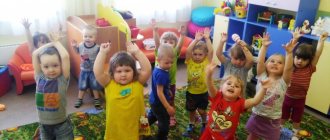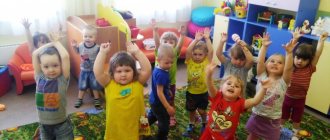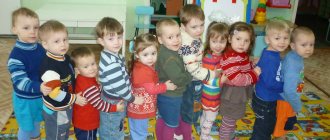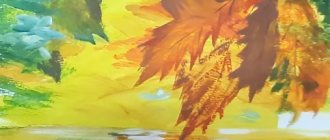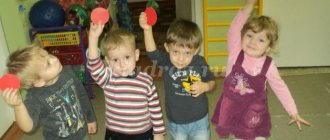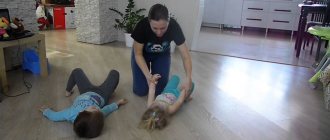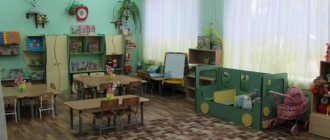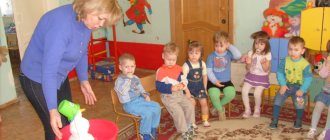Organization of play activities for children of primary preschool age
Progress of the game:
The teacher says that the snowman was in a hurry to visit, but tripped and lost one lump. We need to help the snowmen, the teacher draws attention to the fact that his lumps are white.
The teacher and the children look at the picture of flowers and draw their attention to the fact that the flowers do not have a middle; he invites the children to choose a lid that matches the color of each flower and screw it to the neck.
“What does the figure look like?”
Target:
To develop children's ability to group objects according to shape.
Game material:
Geometric shapes cut from thick material in 4 primary colors.
Progress of the game:
Children are offered geometric shapes - circle, triangle, square. The adult names them. Asks children to find objects in the room or on the street that are similar to these figures. If possible, allows children to trace the outline of these objects with their hands (ball, hoop, cube, plate, aquarium, etc.).
"Let's hide from the rain"
Target:
To develop children's ability to group objects according to shape.
Game material:
Geometric shapes and three umbrella designs are pre-made. An adult places one geometric figure under each umbrella; this is a sample for children.
Progress of the game:
Game situation: “On a warm sunny day, geometric figures went out for a walk. Suddenly a huge gray cloud appeared in the sky, covered the sun and it began to rain. Squares, circles and triangles need to hide from the rain so as not to get wet. Where can I hide?”
"Pick your buttons"
Target:
To develop the ability to group objects by size.
Game material:
2 boxes, large and small, buttons of different sizes (large and small)
Progress of the game:
The teacher, together with the children, arranges the buttons into groups: the largest, the largest, the smallest, etc. Considering the sizes of buttons, compares and applies button to button. The adult activates the children's speech.
"Find a house"
Target:
To develop the ability to distinguish objects by size.
Game material:
Houses made of cardboard of different sizes, bunnies made of cardboard of different sizes.
Progress of the game:
The teacher tells the children that the bunnies are lost and cannot find their house. The teacher invites the children to help the bunnies and find a house for each one.
"Wonderful bag"
The game's task is to consolidate children's knowledge of geometric shapes and develop the ability to guess objects by touch.
Material: Bag, set of Dienesha blocks. Game action Option 1. All figures are put into a bag. Ask your child to touch all the round blocks. Option 2. Offer to get all the square blocks. Option 3. The child takes out all the rectangular blocks. Option 4. Offer to get all the triangular blocks. “What's extra”
The game task is to train children in grouping geometric shapes by color, shape, size, thickness.
Material: bag, set of Dienesh blocks. Game action Place three pieces on the table. The child needs to guess which of the figures is extra and according to what principle (by color, shape, size or thickness). “Find a different figure”
The game’s task is to consolidate children’s knowledge about geometric shapes.
Develop the ability to distinguish figures based on one, two, or three characteristics. To develop speech activity and quick thinking in children. Material: set of Dienesha blocks. Game action: Option 1. Place any figure in front of the child and ask him to find all the figures that are not the same as this one by color. Option 2. Find a figure that is not the same size. Option 3. Offer to find the child a figure that is not of the same shape. Option 4. The child finds a figure that is not the same in thickness as this one. “Beads”
The game’s task is to consolidate children’s knowledge about geometric shapes and colors.
Material: bag, set of Dienesha blocks, colored thread for beads. Game action Option 1. Place a row of figures in front of the child, alternating them by color: red, yellow, red... Make beads like these according to the sample. Option 2. Offer to assemble beads from the figures laid out in front of him, alternating them in shape: triangle, square, rectangle. Option 3. Place a row of figures in front of the child, alternating them by shape or thickness. Make beads according to the teacher's verbal instructions. “Continue the row”
Game task: to consolidate children’s knowledge about geometric shapes, color, size, thickness.
Develop thinking. Material: Dienesha block set. Game action Option 1. We lay out the figures one after another on the table so that each subsequent one differs from the previous one in just one attribute: color, shape, size, thickness. Invite the child to create his own series of figures, following the rule. Option 2. We lay out a chain of Dienesh blocks on the table so that there are no figures nearby that are the same in shape and color (in color and size; in size and shape, in thickness and color, etc.). We invite the child to continue the row of figures. “Treat for the cubs”
Game task: to develop the ability to compare objects according to one to four properties.
Material: 9 images of bear cubs, Dienesh blocks. Game rule: The bear cubs must have different cookies in both paws. Game action Option 1. Bear cubs came to visit the children. What will we treat our guests to? Our cubs have a sweet tooth and really love cookies, of different colors and shapes. Let's give the cubs a treat. The cookies in the left and right paws should differ only in shape (color, size, thickness). If the bear cub has a round “cookie” in his left paw, his right paw can have either a square, rectangular, or triangular (not round). In all variants, the child chooses any block of “cookies” in one paw, and selects it with the other according to the rule proposed by the teacher. Option 2. Games using cards with property symbols. Sequence of actions (algorithm) of the game. Cards with property symbols are placed in a stack face down. The child takes any card from the pile. Finds “cookies” with the same property, etc. “What has changed”
Game task: to improve children’s knowledge about geometric shapes, their color, size, thickness.
Material: set of Dienesha blocks. Game action Option 1. Several figures are laid out on the table that need to be remembered, and then one of the figures disappears. The child should notice the changes. Option 2. The child memorizes the figures, and then one or two figures change places. Option 3. One or two figures are replaced with a new one. “Snail”
Game task: to train children in classifying blocks according to two characteristics (color and shape).
Material: playing field with a spiral image or colored braid, a set of blocks. Game rule: start from the middle of the spiral, attach a block similar in color or shape. Game action The teacher offers to build the children a house for a snail from magic figures. The house will turn out elegant and beautiful. Laying out the blocks begins from the middle of the spiral. One block is taken randomly, then a block is added in which one feature of the previous block will be present. “Help Bear and Bunny”
Game task: to improve children’s knowledge about geometric shapes, their color, size, thickness.
Material: toys (bear, doll, hare), Dienesh logic blocks. Game action Option 1. Invite the children to divide the pieces between the bear and the bunny so that the bear has all the red pieces. Invite them to answer the questions: What shapes did the bear and bunny have? Option 2. Try dividing the figures differently: a) so that the bear has all round ones; b) so that the hare gets all the big ones; c) so that the hare gets all the yellow ones. Option 3. A more complex version of this game: divide the pieces so that the bear has all blue ones, and the bunny has all square ones. Check which pieces only the bear got? (Blue, non-square). Only for the bunny? (Square, not blue). Which figures suited both the bear and the bunny at once? (Blue, square). And what figures did not suit anyone? (Not blue, not square). “Assignments”
Game task: to develop the ability to distinguish and name toys, as well as highlight their size;
develop auditory perception, improve understanding of speech. Material: large and small dogs, cars, boxes, balls, cups, cubes, matryoshka dolls. Game action Option 1. Show the child toys and objects and invites them to name them, noting their size. Then give the baby the following task: Give the big dog tea from a large cup, and the small dog from a small cup. If the child makes a mistake, the dog or matryoshka shows its displeasure (growls or turns away). Option 2. Ride the nesting doll in a big car. Option 3. Place a small dog near the nesting doll. Option 4. Build a house from large cubes for a large dog, and from small ones for a small dog. Option 5. Take a small dog and sit it on the carpet. Option 6: Take a big dog and put it in a big box. Option 7. Collect small cubes in a small box, and large ones in a large one. “Treat the Bunny”
Game task: to develop children’s ability to group objects by size.
Materials: a toy hare, a large and a small bucket, five large and small dummies of carrots on a tray. Game action Option 1. Show the hare, invite the child to look at it, stroke it. The bunny asks you to help him collect carrots and shows a tray with carrots, emphasizing that the carrots are large and small. Large carrots should be placed in a large bucket, and small carrots should be placed in a small bucket. Option 2: Group items by color. “Mand your pants”
Game task: to develop the ability to correlate objects by shape, color, size.
Material: cardboard image of a wolf (matryoshka, doll) with round, square and triangular holes on the pants and corresponding circles, squares and triangles, the same color as the pants. Game action Option 1. The teacher shows the children a wolf and draws their attention to the fact that the wolf has holes in his pants. Show the children geometric shapes - patches and offer to help the wolf mend his pants only with triangular patches. Option 2: Mend the patches with red and blue patches only. Option 3. Mend only green rectangular ones. Option 4. Darn only with yellow round ones and blue rectangular ones. Option 5. “Match” sundresses of different colors on the nesting dolls with various large and small geometric shapes of the corresponding colors. “Funny Men”
Game task: to improve the ability to group objects by shape, to consolidate the name of geometric shapes.
Material: circle, square, triangle, rectangle cut out of cardboard - houses and the same small geometric shapes - people. Game action Option 1. Offer to look at small geometric shapes (funny people) randomly lying on the table. Then we show, for example, a circle and say: “This little man’s name is a circle. What is the little man's name? (Circle). Show me what other little people are called circle? (Children show circles).” The baby is also shown other geometric shapes. Option 2. Invite the little people to find their houses. Explain that circle men live in a round house (place the man on a large circle), square men live in a square house (place the man on a large square). This game is played first using two geometric shapes, then three and then four. At the first stages, the little people are the same size and color; to complicate the game, you can use “people” of different sizes, and then colors. “Help the nesting doll find its toys”
Game task: to consolidate the ability to group homogeneous and correlate dissimilar objects by color.
Material: pattern with nesting dolls, beads and sticks of different colors. Game action Option 1. Show the nesting dolls one by one, dressed in dresses of four primary colors and tell that each nesting doll has its own toys: balls and sticks, but they are all mixed up. Help the nesting dolls find their toys. Shows one of the nesting dolls and offers to choose beads of the same color as her dress. Option 2. Complication. After the child selects all the beads and places them next to the matryoshka doll, he is asked to choose the sticks in the same way. “Inserts”
Game task: form the pour and call it geometric shapes (circle, square, triangle), develop memory, thinking and attention.
Material: inserts “Bunnies” (large and small), “Dogs” (ascending). Game action Option 1. The child examines geometric shapes, names them and shows them. Correlates the “Bunnies” inserts by height, the “Dogs” inserts in ascending order to show the adult. Option 2. Completes the task according to the sample (picture or diagram). Option 3. Independently according to the verbal instructions of the teacher. “Multi-colored balls and clothespins”
Game task: continue to develop fine motor skills of the hands, consolidate knowledge of primary colors, develop attention and imagination.
Material: balls and clothespins of primary colors and corresponding colors of the box. Game action Option 1. “Grandma” comes and complains that the kittens have unwound all the balls. Offer to wind a ball. Option 2. Complication. Hang clothespins on the handle of the basket. Constantly involve children in productive activities. “Multi-colored drops”
Game task: continue to develop children’s sensory abilities, the ability to pipette and drop into cells by color, develop memory and thinking.
Materials: pipette, jars with gouache of primary colors, palette. Game rule: carefully pick up the appropriate color using a pipette. Game action Option 1. Show jars with multi-colored gouache. Provide a drawing and a palette with cells by color (2 colors). Shows actions. Then he invites the children, following a verbal guide, to type in a jar and drop into the cells without mixing the colors. Each action is discussed with each child. Option 2. Complication - four colors. Option 3. Complication – six colors “Lace up the boot”
Game task: to develop the ability to perform actions with lacing, to develop sensory abilities.
Material: boots, matching color laces. Game rule: lace up the boot with the corresponding color of the lace. Game action Option 1. Offer to lace up a boot of the same color with laces. Option 2. Lace up only red boots. Option 3. Lace up only green boots. Option 4. Lace up red and blue boots. “Fold the rainbow”
Game task: to develop sensory abilities and color perception. Material: a rainbow of seven colors divided into two halves. Game rule: match the colors of the rainbow. Game action Option 1. Consider the halves of the rainbow with your child. Assemble one half yourself, and invite the child to assemble the other half, naming the colors. Option 2. Complication - assemble it yourself.
